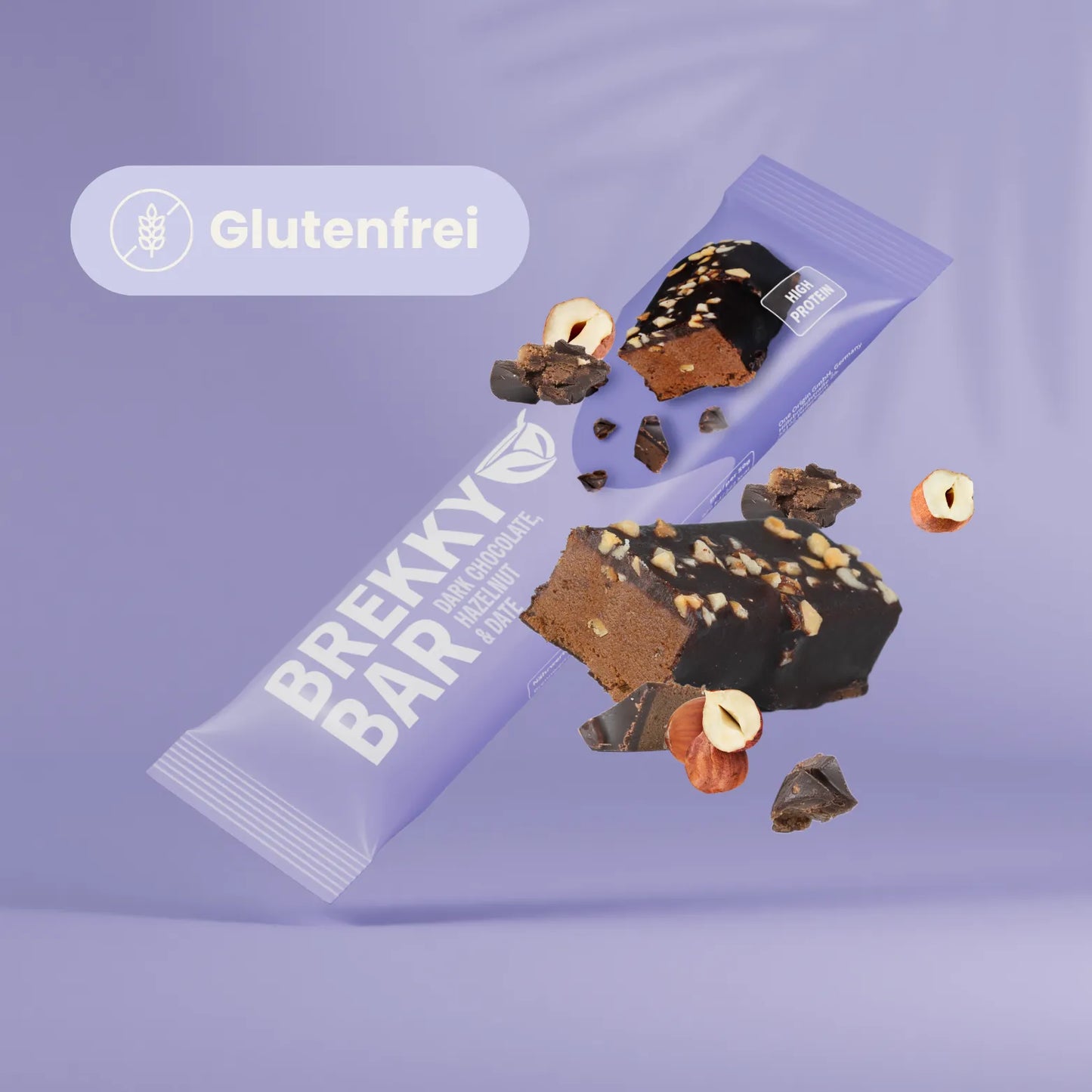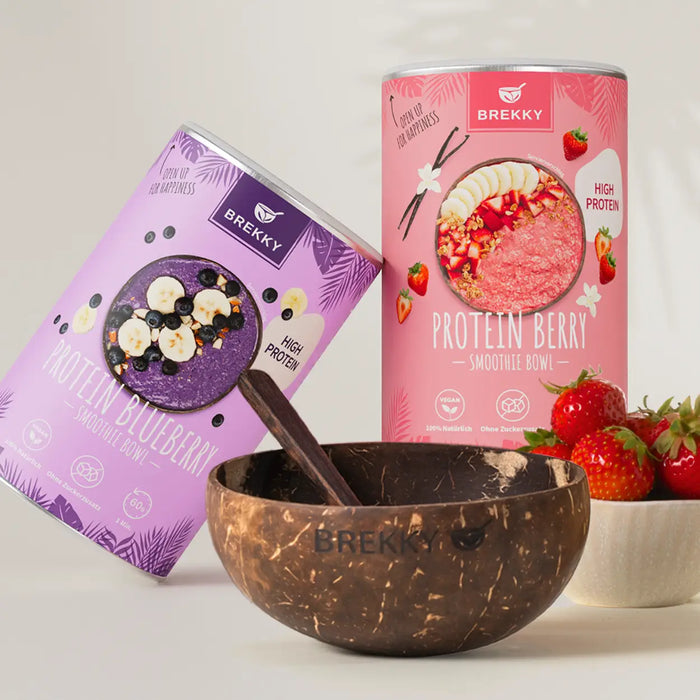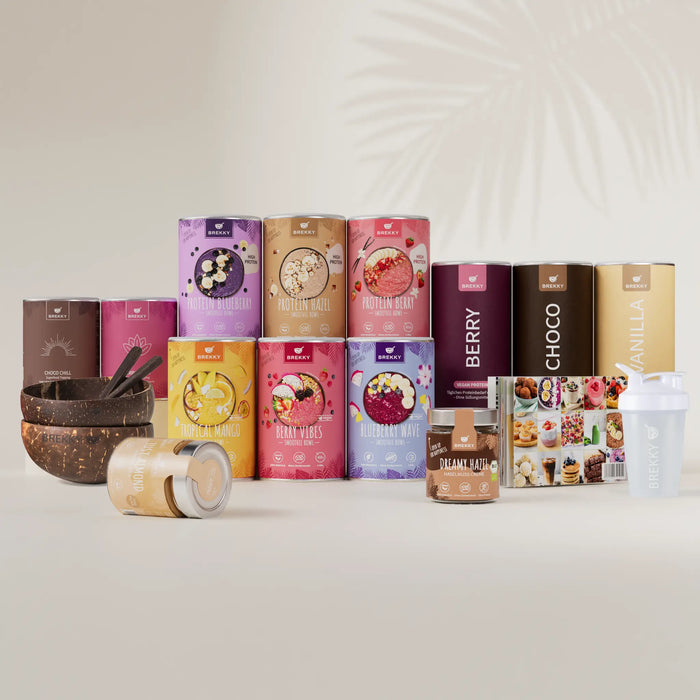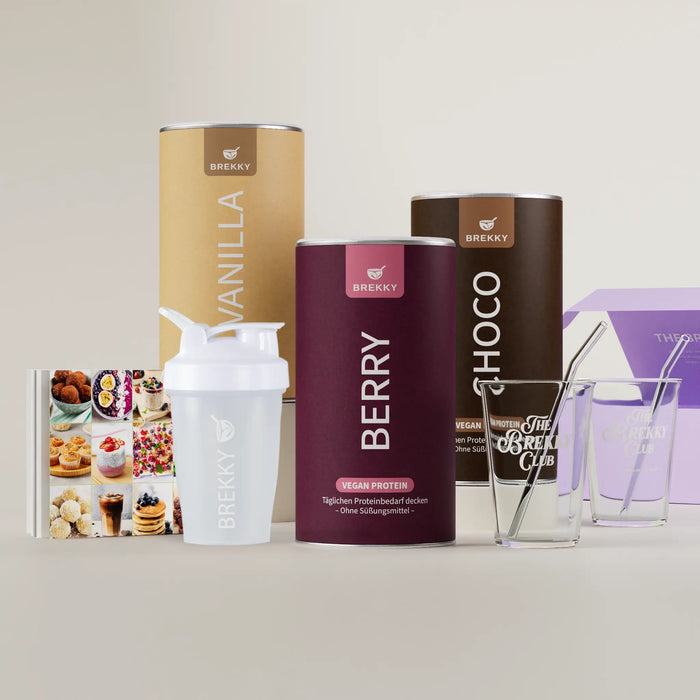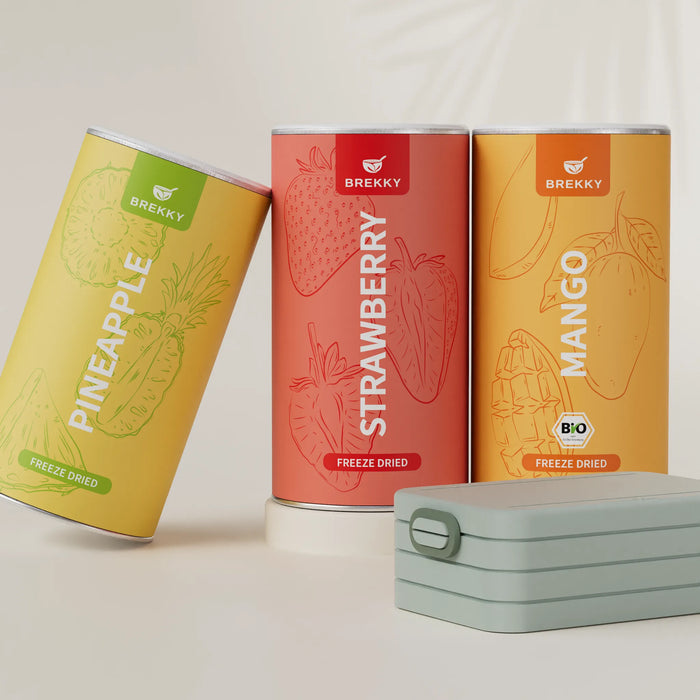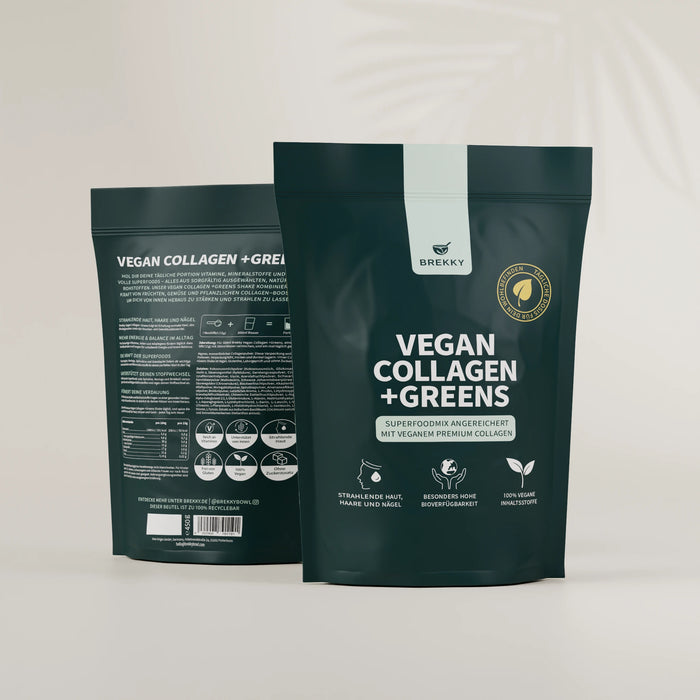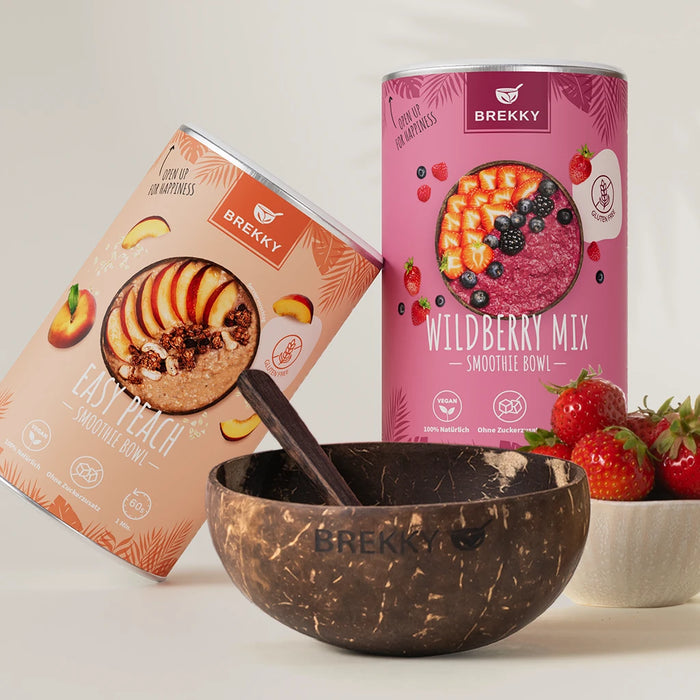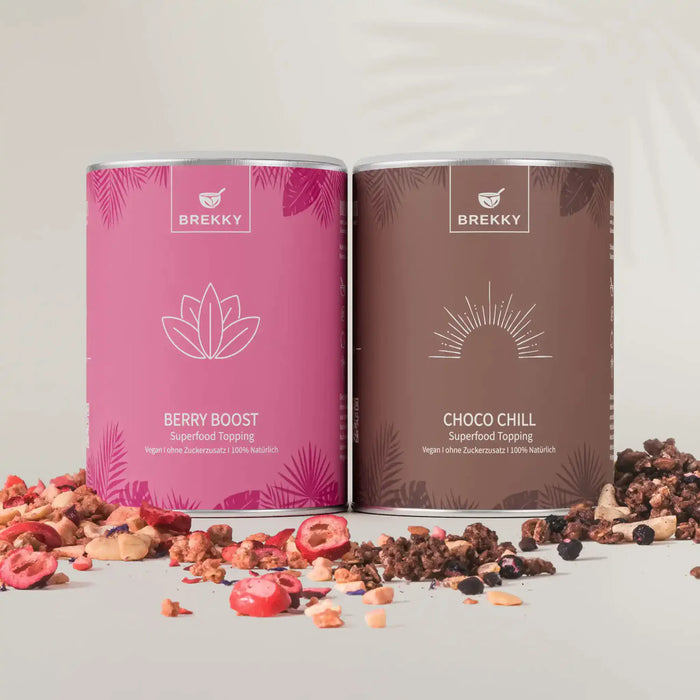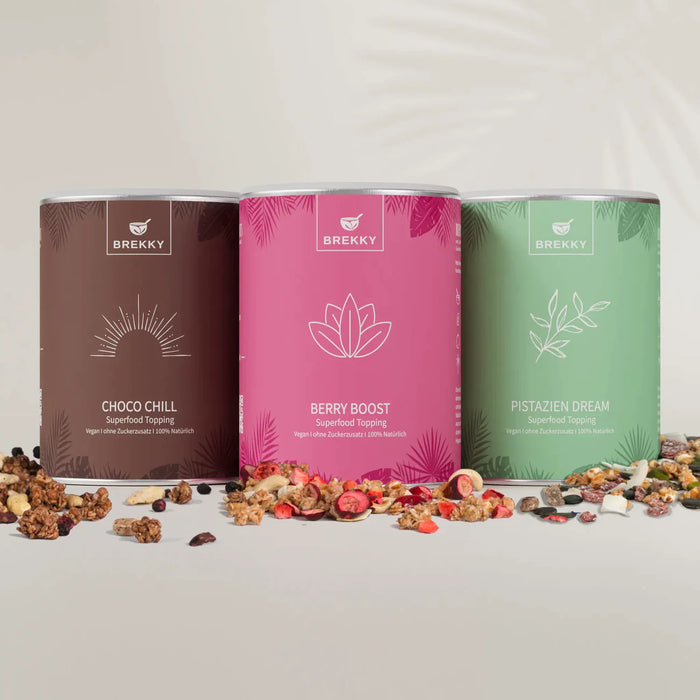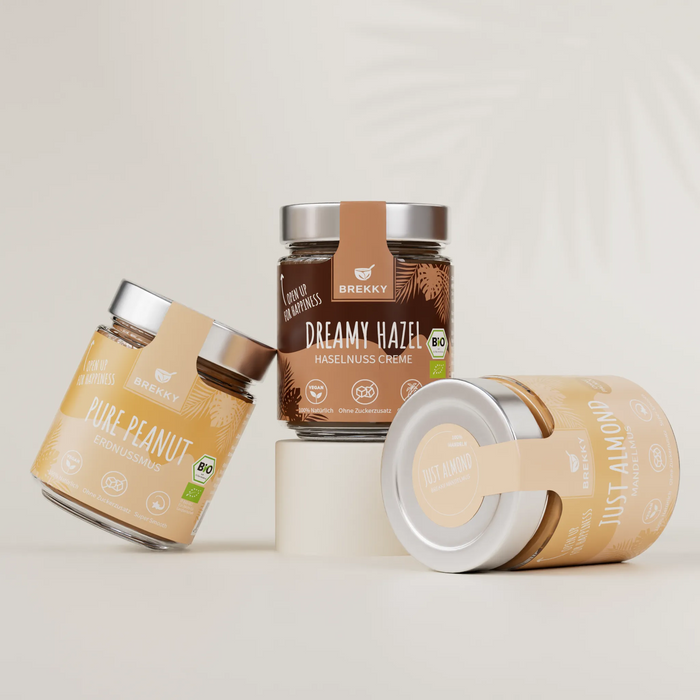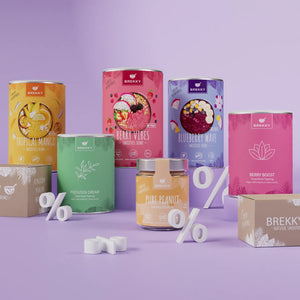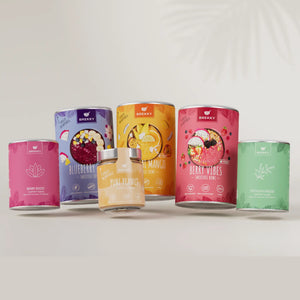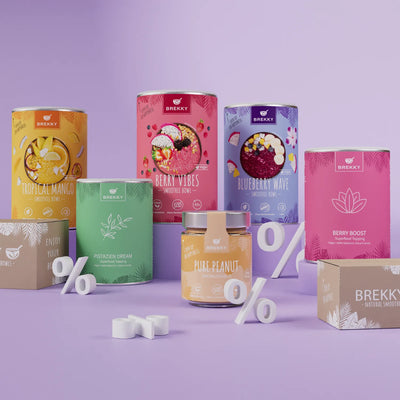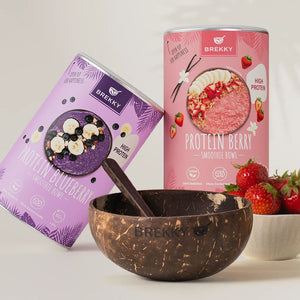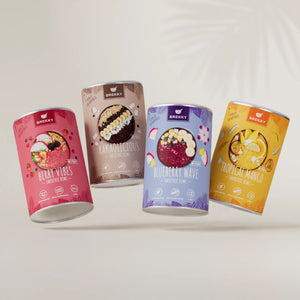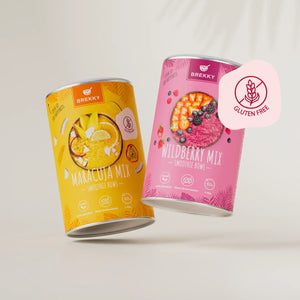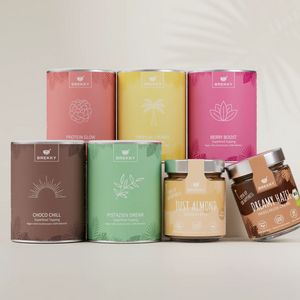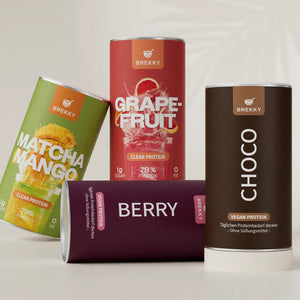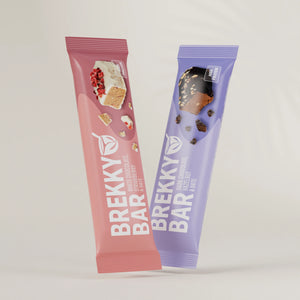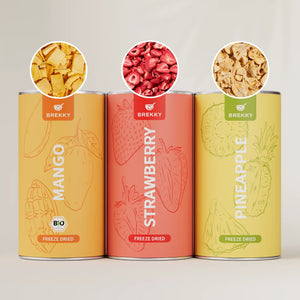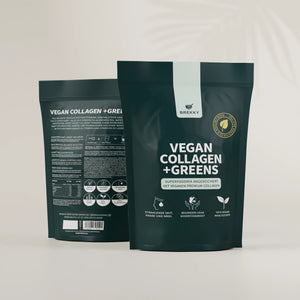Gesundes Frühstück für Kinder: Dein umfassender Leitfaden von Kita bis Schule
Inhalt
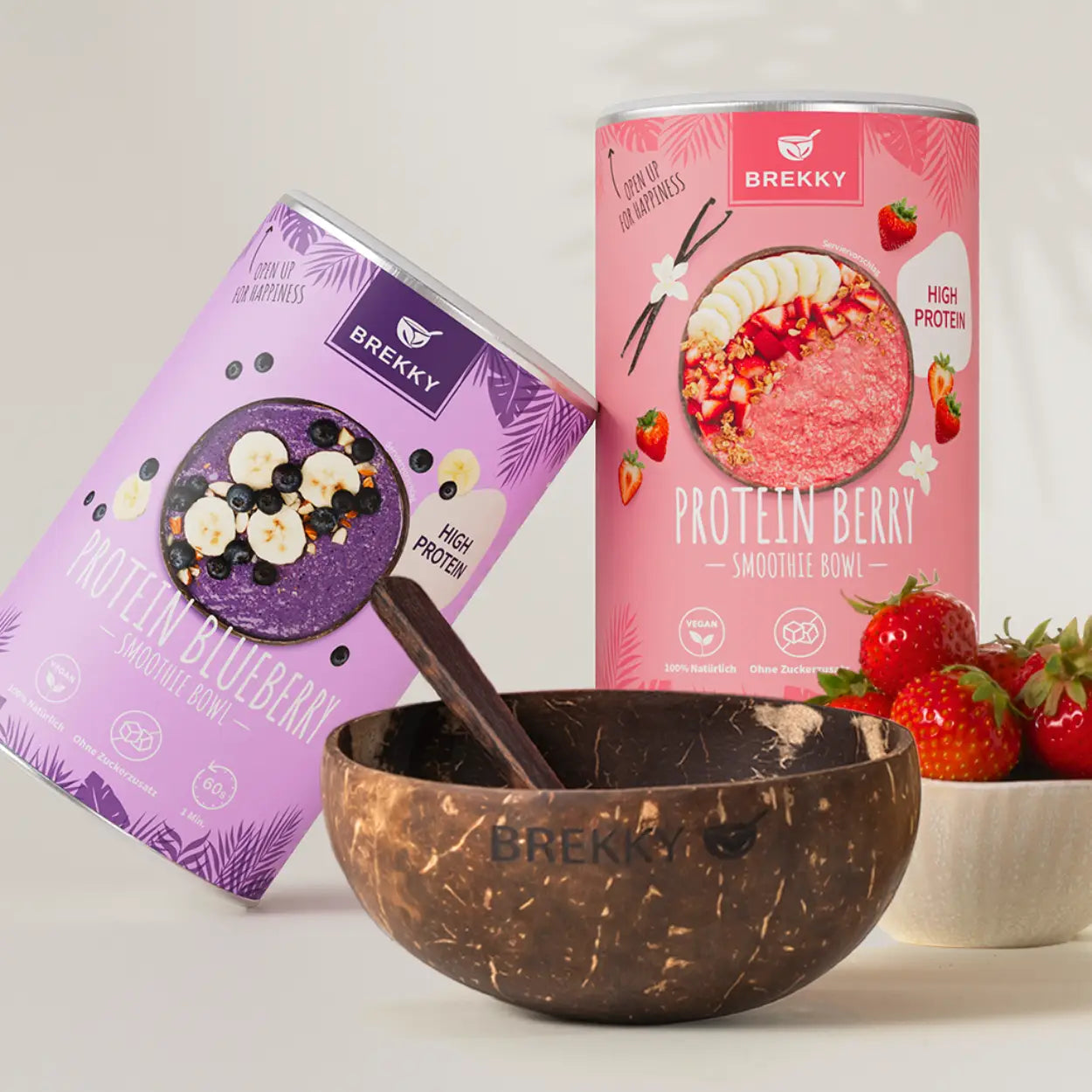
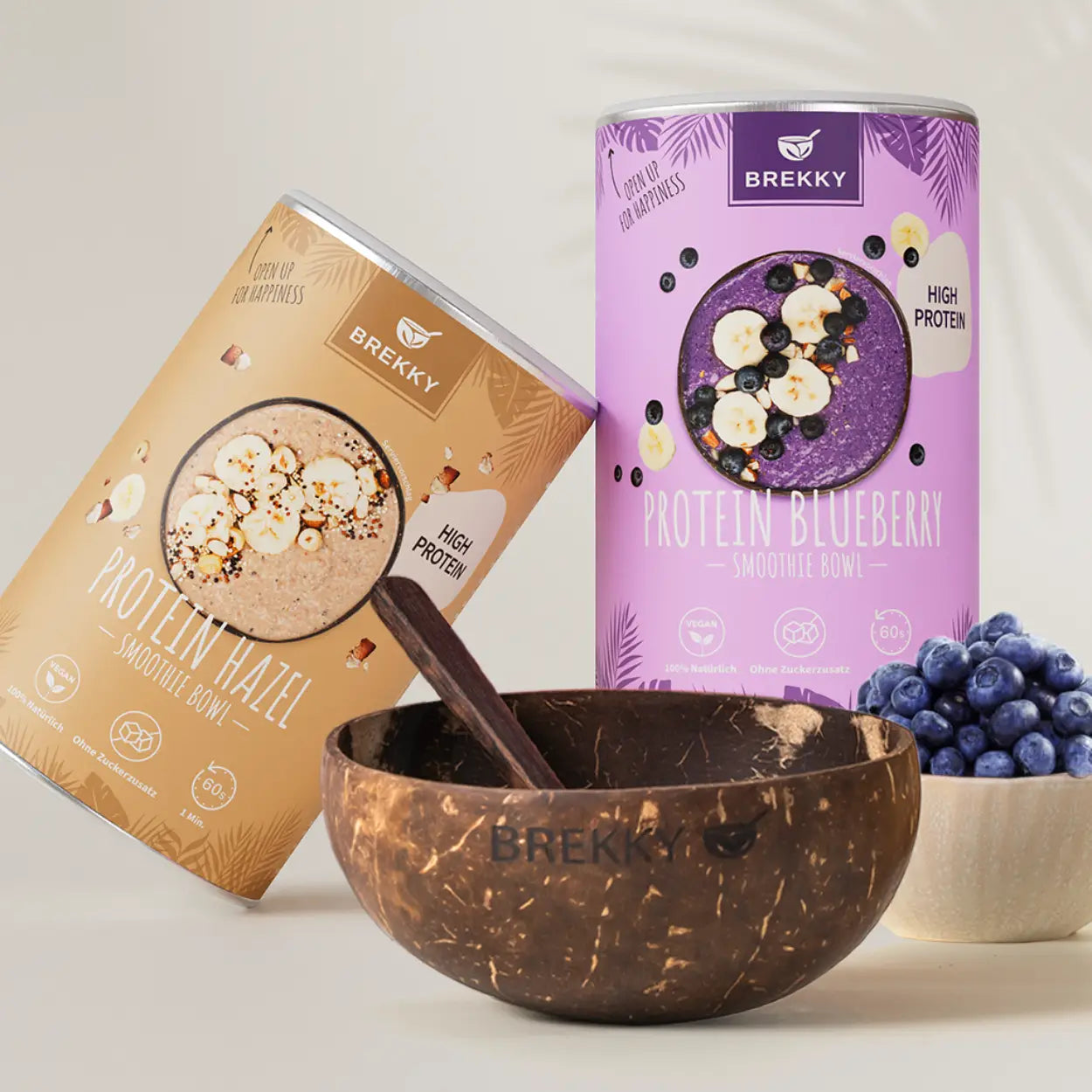
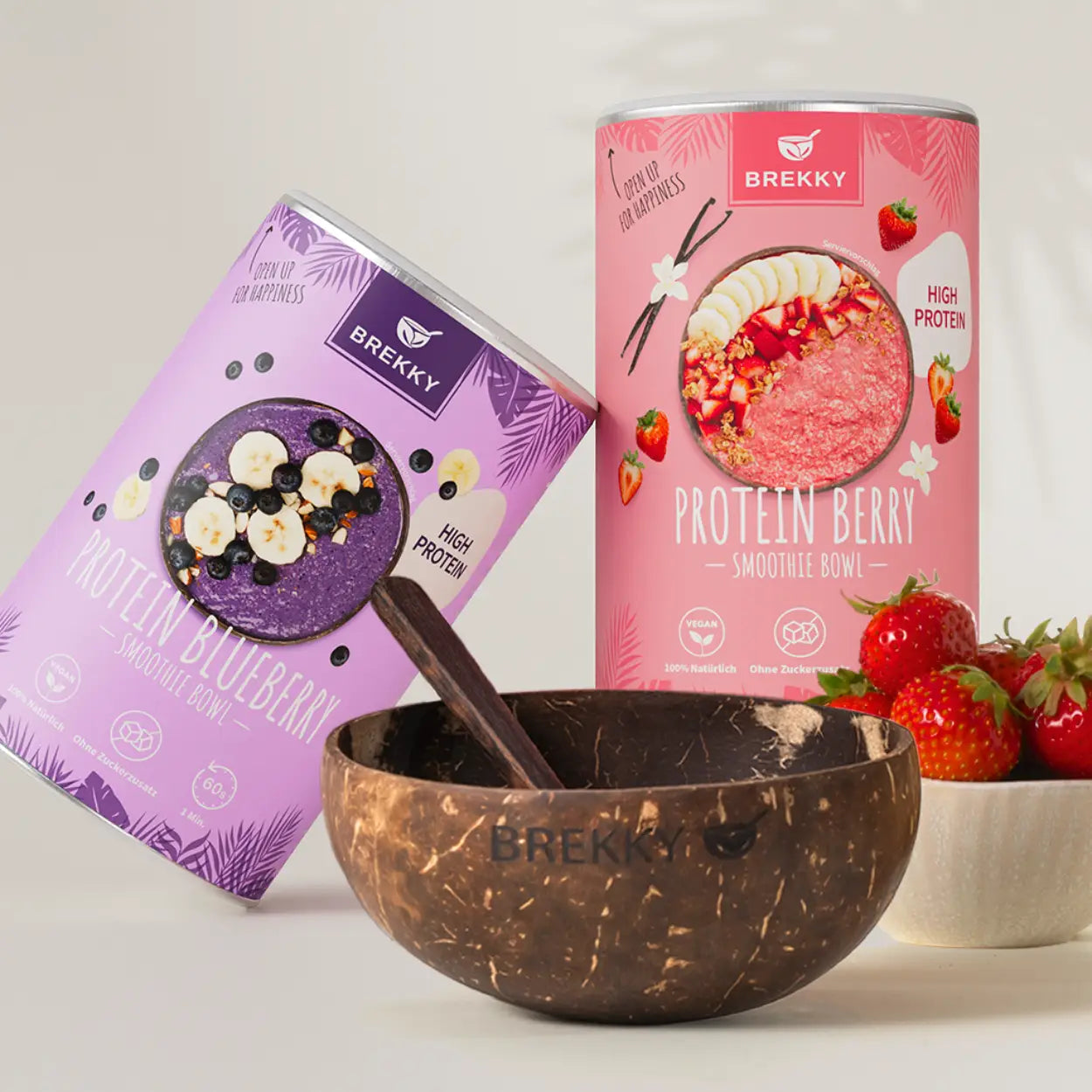
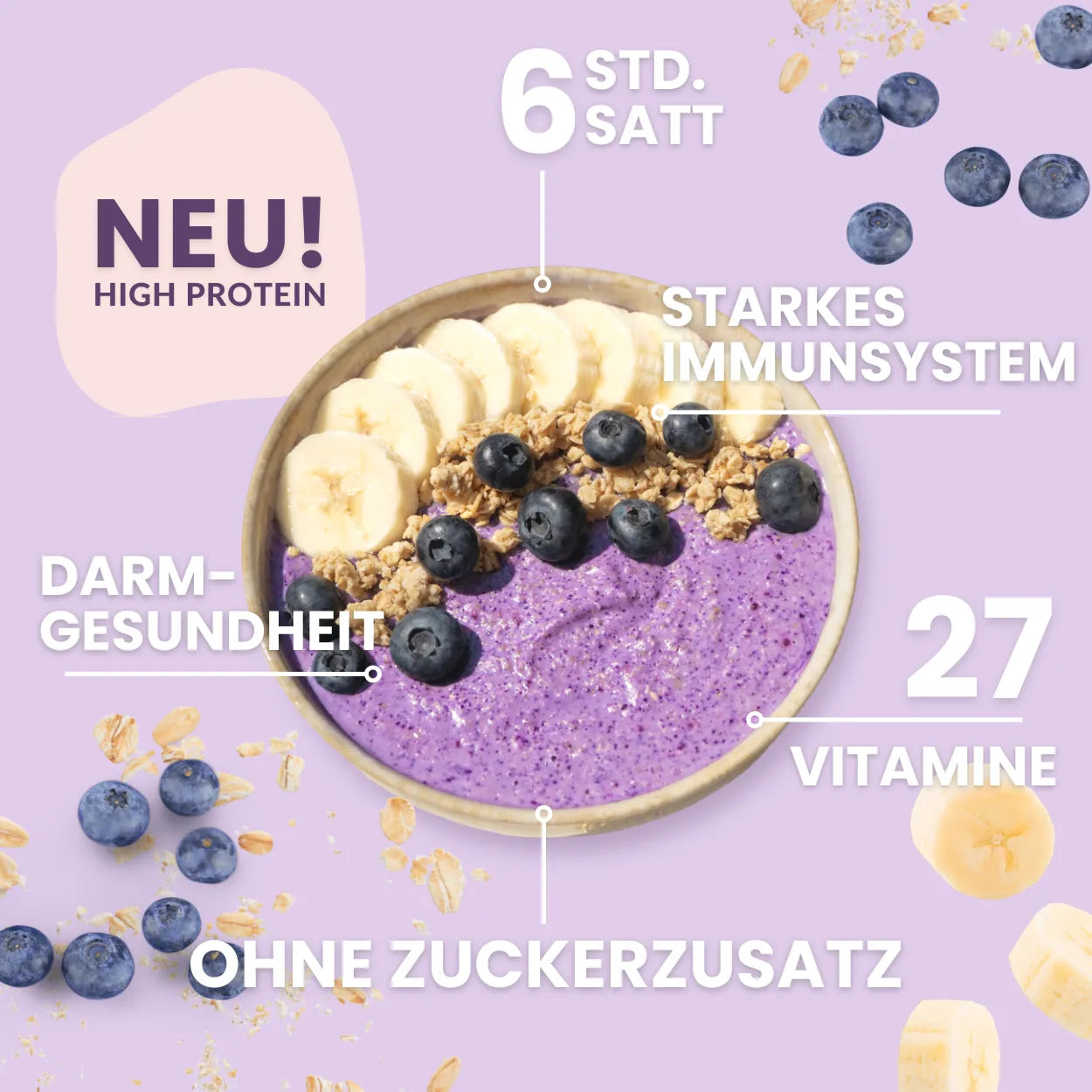
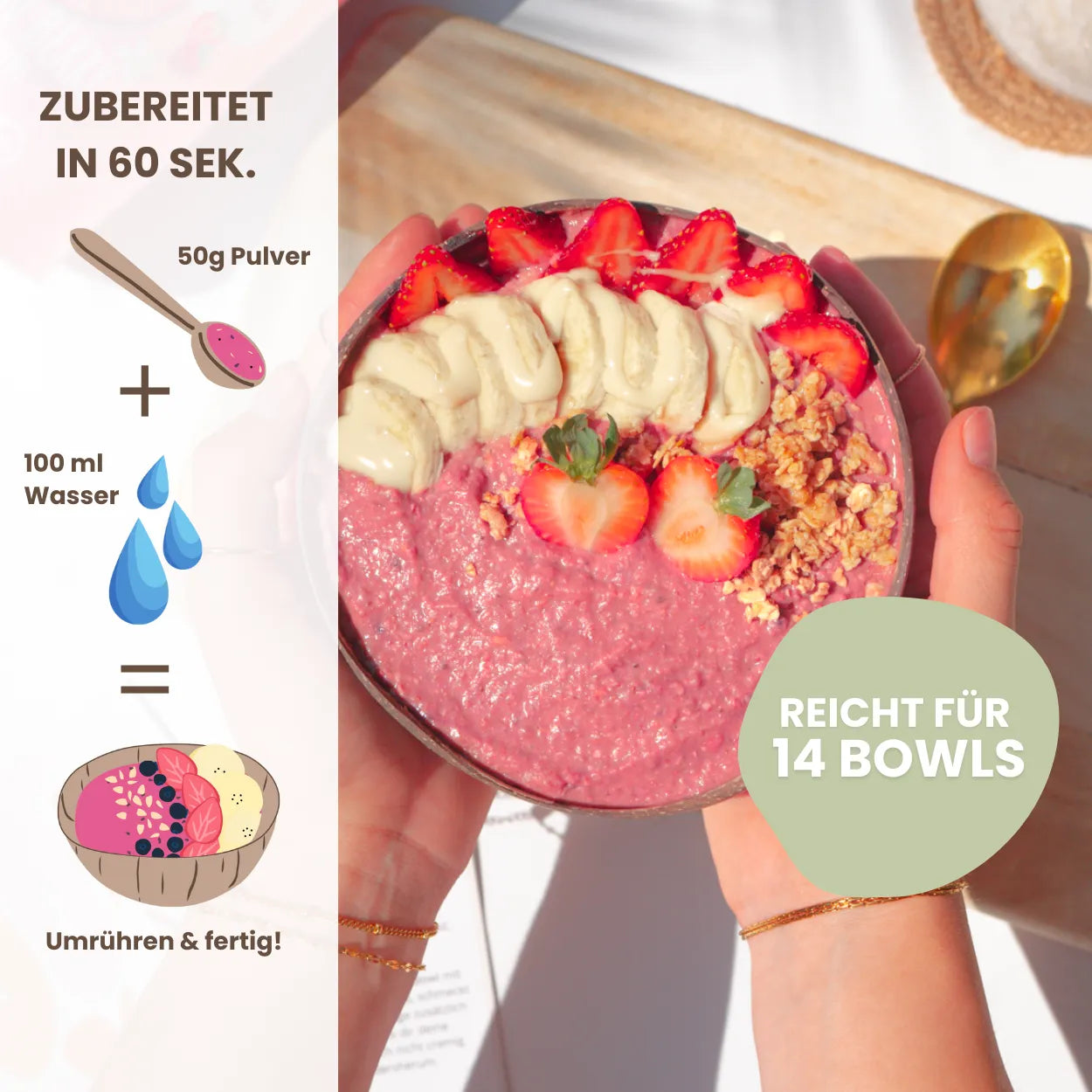
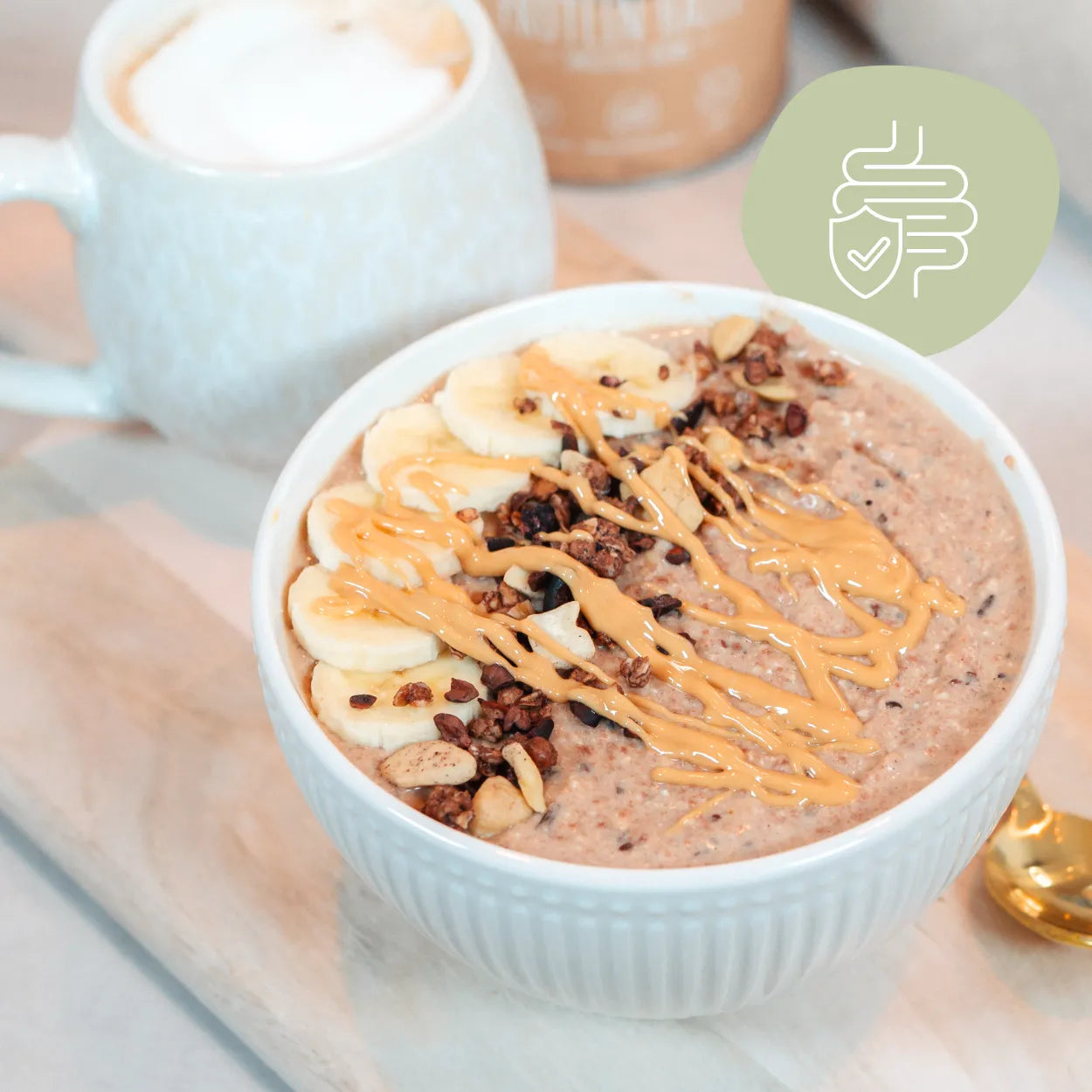

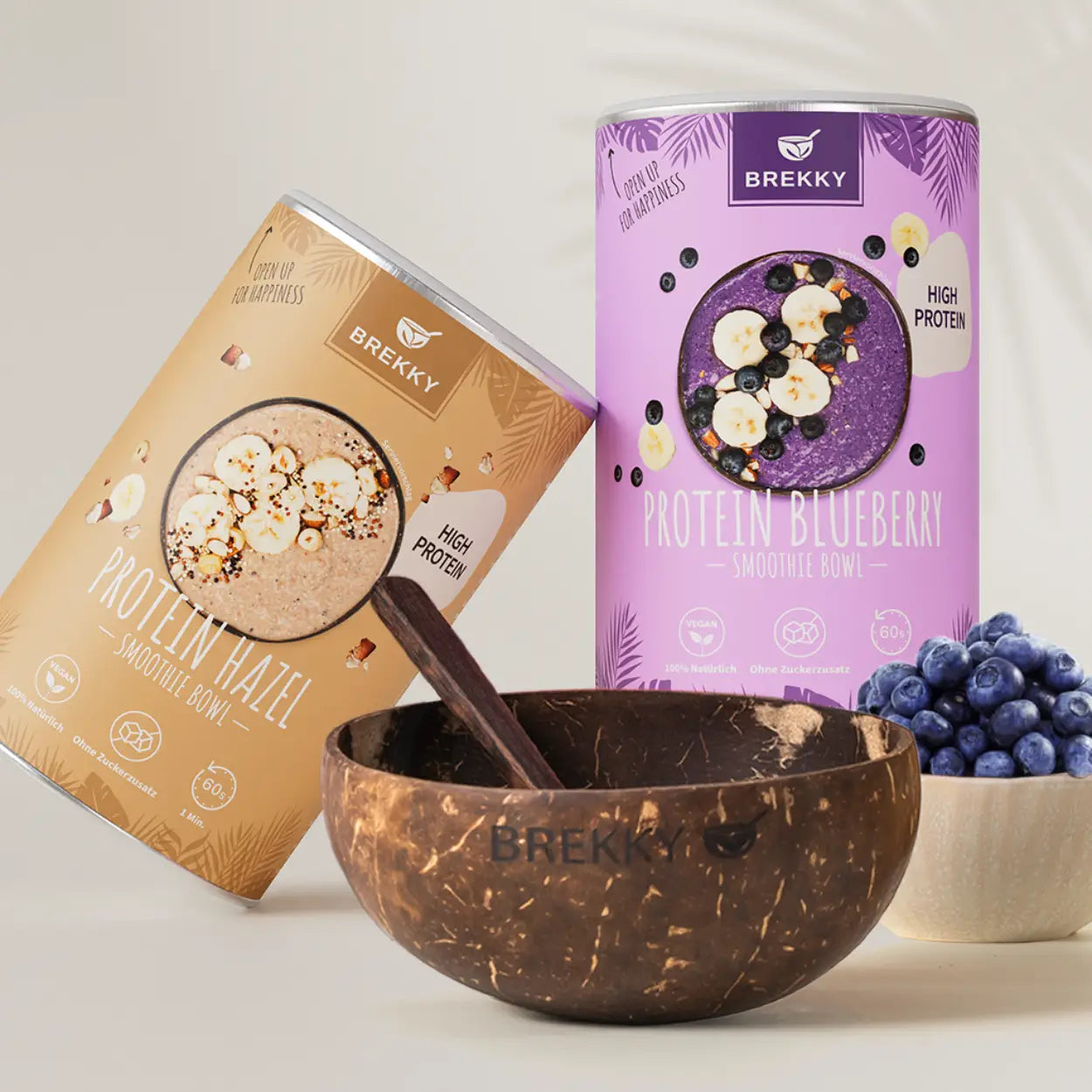
Basics of a healthy children's breakfast
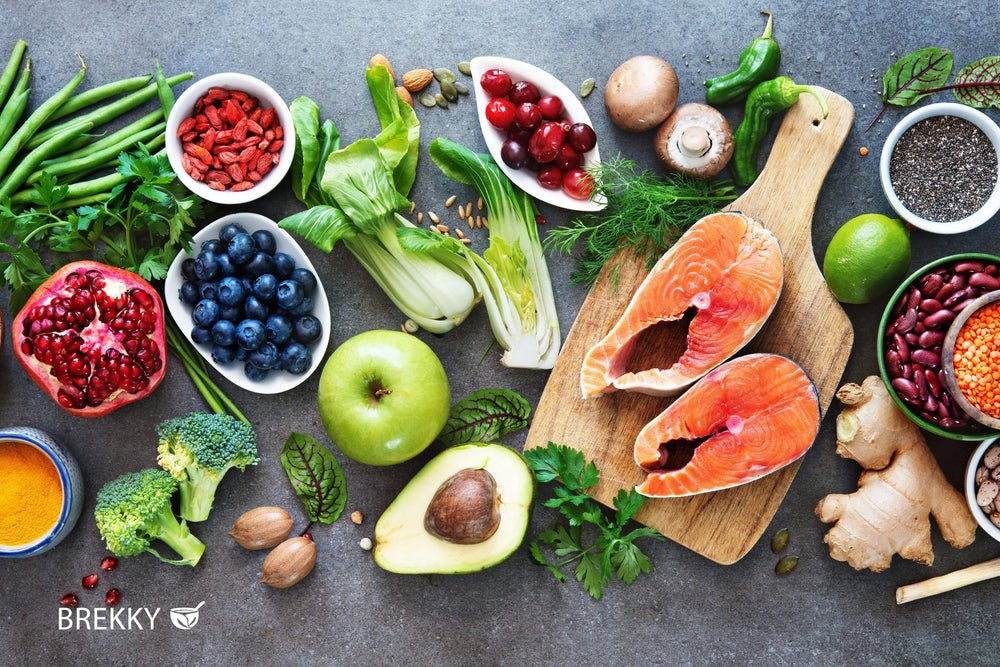
Nutritional needs of children in the morning
- Carbohydrates : Complex carbohydrates are essential for children because they provide a long-lasting energy supply. Whole-grain products such as whole-grain bread, oatmeal, or whole-grain pasta (exceptionally in the morning) ensure stable blood sugar levels. It's especially worthwhile to focus more on these foods for breakfast before daycare or school.
- Proteins : Protein is a building block for growth and repair processes in the body. Low-fat curd cheese, natural yogurt, cottage cheese, eggs, or lean sausages (e.g., poultry) are good options for providing children with sufficient protein.
- Healthy fats : High-quality fats, such as those found in nuts, seeds, avocados, or flaxseed oil, support brain and nerve function. A spoonful of nut butter in muesli or a few flaxseeds in yogurt can make a big difference.
- Vitamins and minerals : Fruits and vegetables provide important vitamins and minerals that strengthen the immune system and protect the body from infections. To make breakfast child-friendly, it's worth offering vegetables in attractive ways—for example, in sticks or small portions—so they're more likely to be eaten.
- Fluids : Don't forget to drink! Water or unsweetened tea are ideal accompaniments to breakfast for children. Sweetened drinks should be the exception.
Recommendations of the German Nutrition Society (DGE)
The German Nutrition Society recommends a balanced breakfast that includes a combination of whole-grain products, dairy products (or plant-based alternatives), and fruit and vegetables. This variety ensures that all essential nutrients are present in sufficient quantities. These recommendations can be particularly well-implemented for breakfast at daycare or school, for example, by topping whole-grain bread with cream cheese and sliced cucumber or tomatoes, along with a small piece of fruit.
Balance between carbohydrates, proteins and healthy fats
The trick is to not neglect any nutrient group. It's easy to end up with a breakfast that's too "carbohydrate-heavy," for example, if only sweet rolls or highly sugared cereal end up on the table. This causes blood sugar levels to rise briefly but then fall again quickly. The consequences are difficulty concentrating, fatigue, and early hunger pangs. A good balance, for example, consisting of whole-grain bread, some cheese, a piece of fruit, and a glass of water or unsweetened tea, keeps children full for a longer period and provides stable energy.
Drinks for breakfast
A healthy children's breakfast includes appropriate drinks. Still or sparkling? Flavored or plain? Generally, you should always ensure that children get plenty of fluids. Water and unsweetened teas are the best choices. If children don't like water or tea, a squeeze of orange juice (1:4 with water) can be a compromise. Avoid sodas and sweetened juices as much as possible, as they contain a lot of sugar and unnecessary calories.
If you consider these basics, you already have a solid starting point for a healthy and child-friendly breakfast. However, every age has different requirements: A breakfast for a 1-year-old child is very different from what a school-age child needs. Therefore, in the next section, we'll look at how to adapt breakfast to suit different age groups.
Breakfast ideas for different age groups
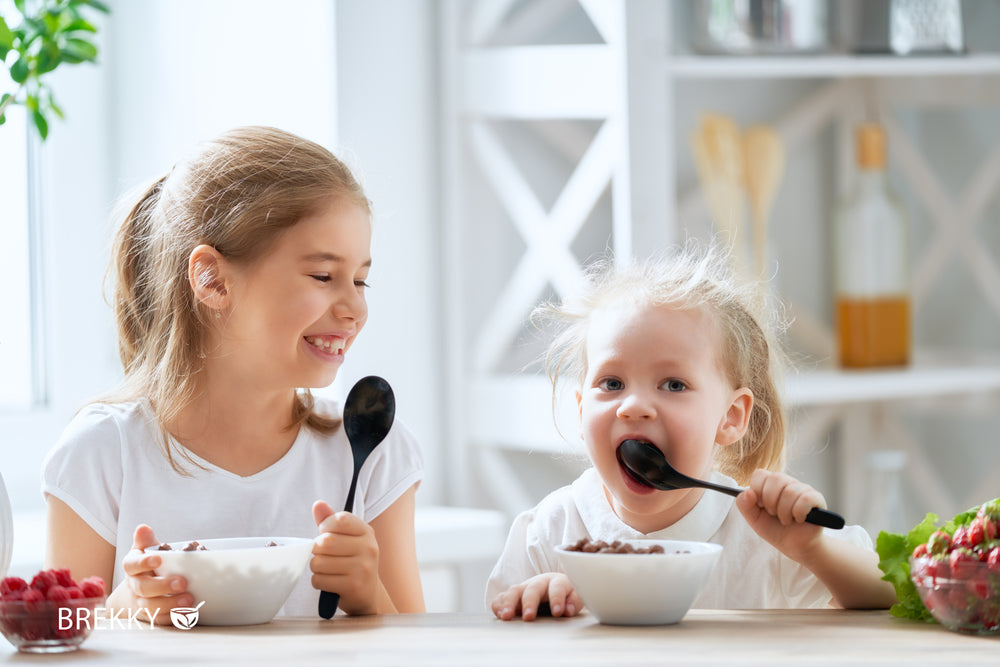
Breakfast for toddlers (1–3 years)
During this phase, children are just discovering many foods. A varied breakfast for children of this age often means carefully introducing new tastes and textures.
- Soft textures : For example, porridge, rice pudding (with little sugar), soft oat flakes in warm milk, or plant-based alternatives. Homemade fruit puree made from apples and pears is also great for mixing.
- Finger food : Diced soft fruit (e.g. banana, soft pear pieces) or cooked vegetables such as carrot sticks are ideal.
- First bread experiences : Whole-grain bread should be as finely ground as possible. Spread with cream cheese, mild cheese, or soft fruit puree to gently introduce young children to the texture.
- Drinks : Water or highly diluted, unsweetened tea are good companions. Make sure children this age drink enough, as their body water percentage is very high.
Breakfast for kindergarten children (3–6 years)
Kindergarten children become increasingly independent and discover their own preferences. A diverse selection promotes a love of food and encourages little ones to try new things.
- Whole-grain products : Simple yet delicious whole-grain breads or rolls with various spreads, such as hummus, avocado, or cream cheese. Sweet versions with unsweetened fruit spread are also possible.
- Muesli Variety : Mild whole-grain muesli with no added sugar, combined with milk, yogurt, or plant-based alternatives. Enriched with fresh berries or seasonal fruit, it becomes even more appealing.
- Lunchbox ideas : Bite-sized portions are ideal for kindergarten. Vegetable sticks, chopped fruit, and perhaps a hard-boiled egg make for a good, balanced breakfast.
- Drinks : Water or unsweetened herbal and fruit tea. You can try different varieties to introduce children to different flavors.
Breakfast for school children (6–12 years)
School requires concentration. Therefore, a healthy breakfast is especially important for children of this age group. They are on the go for longer periods and need a long-lasting source of energy.
- Savory Breads : Whole-grain bread with cottage cheese, cucumber, and lean ham or cheese provides high-quality protein and complex carbohydrates.
- Second breakfast : Many schoolchildren have a light breakfast at home and then take a second breakfast with them to school. Whole-grain sandwiches or wraps, combined with vegetable or fruit sticks, are ideal for this "breakfast snack."
- Warm options : A warm breakfast for children can give them a good energy boost – for example, a quick porridge made from oats, milk or plant-based drinks, some fruit and a few nuts.
- Snacks for in between meals : Muesli bars without added sugar, low-fat natural yogurt in a reusable container, or vegetable sticks are ideal for avoiding energy dips before lunch.
These ideas can be adapted and expanded as desired. It's important to involve children in a playful way. Let them help with the preparation or choose items they like for breakfast. This way, they learn early on why a healthy breakfast is important and will be able to maintain a balanced diet on their own.
Schnelles und gesundes Frühstück für hektische Morgen
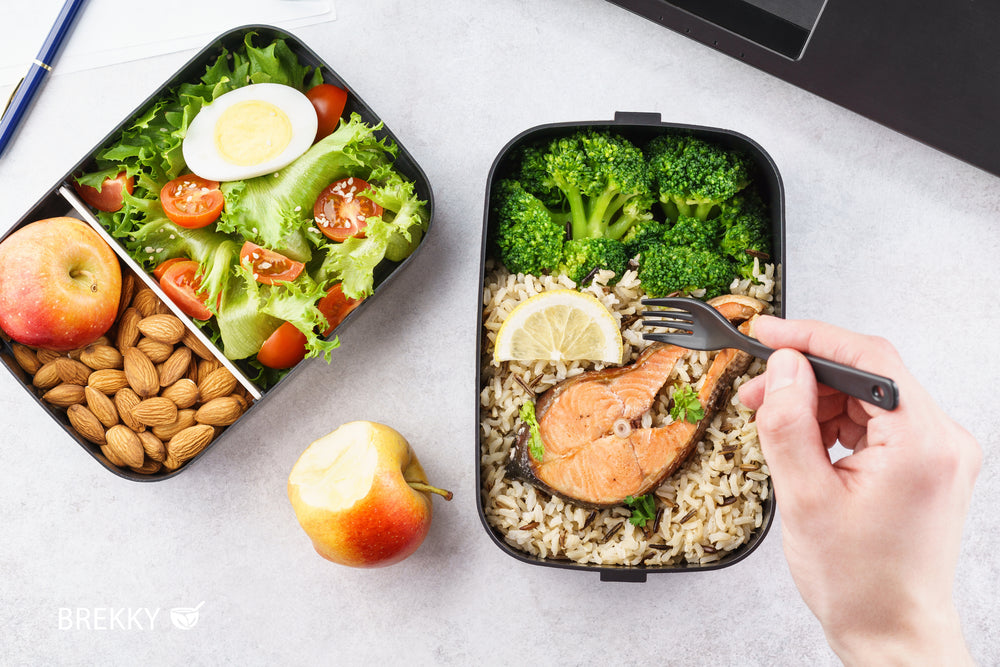
Preparation tips for the evening before
- Pre-cut ingredients : You can wash and cut the fruits and vegetables you plan to use in the morning the night before, and store them in airtight containers in the refrigerator. This will save you valuable minutes in the morning.
- Overnight oats or cold porridge : Mix oatmeal with milk, yogurt, or plant-based milk, add nuts, seeds, or berries, and let the mixture sit overnight. In the morning, all you have to do is stir it again—and you have a quick and healthy breakfast.
- Prepare lunch boxes : Pack breakfast ideas for the next day in your child's lunch box. This way, you can prepare a breakfast for daycare or school and take it with you.
5-minute breakfast ideas
- Smoothies : A quick way to incorporate fruit and even vegetables. Simply blend banana, berries, spinach, or cucumber with a little liquid and add some oatmeal if desired. Be careful not to use too much fruit juice to keep the sugar content in check.
- Quick sandwich : Top whole-grain bread with cream cheese and turkey breast, along with a few lettuce leaves. Wrap in aluminum foil or reusable wax paper and take it with you.
- Yogurt with toppings : Natural yogurt (or a plant-based alternative) can be quickly enhanced with berries, nuts, and seeds. Add a few oatmeal flakes, and you have a nutritious breakfast for kids.
Healthy breakfast options for on the go
Schoolchildren who leave home early in the morning especially like to grab handy snacks. Making a quick and healthy breakfast suitable for children can look like this:
- Muffin tins : Savory muffins made with whole-wheat flour, eggs, milk, and vegetables like peppers or zucchini. These can be baked on the weekend and will keep for a few days in the refrigerator.
- Wraps : Spread hummus or cream cheese on whole-wheat tortillas, wrap them in some lettuce, cucumber, and perhaps cheese or turkey strips. Cut into pieces, and you've got delicious snacks.
- Homemade granola bars : Made with oat flakes, dried fruit, nuts, and a little honey or maple syrup as a thickener. Kids love these bars, and they're significantly healthier than ready-made, often sugary alternatives.
With these tips, a healthy breakfast for children is achievable even in the hectic pace of everyday life. Even if time is short, you can ensure quality and balanced nutrition. Most importantly, plan a little in advance and keep basic ingredients like whole grain products, yogurt, or fruit on hand.
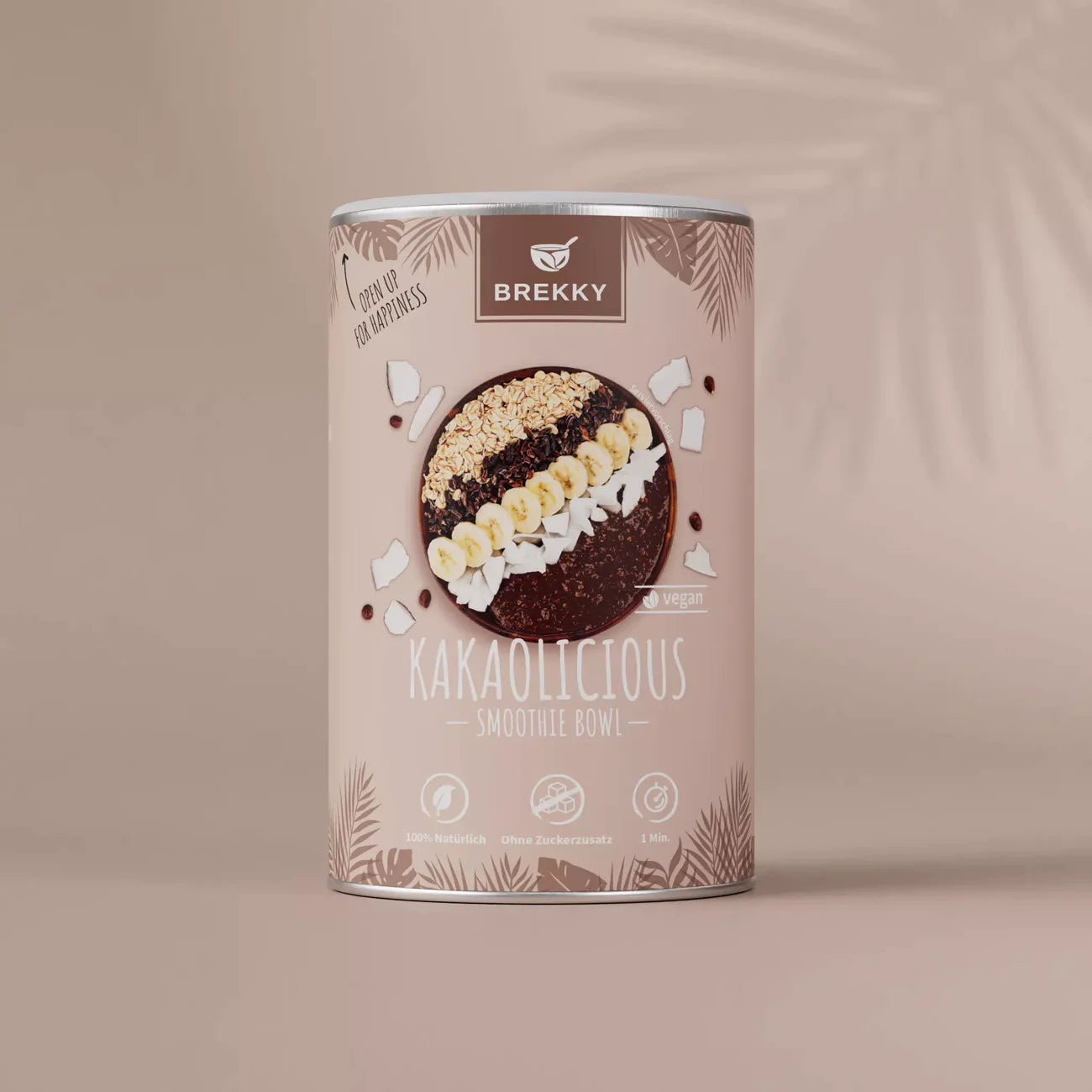
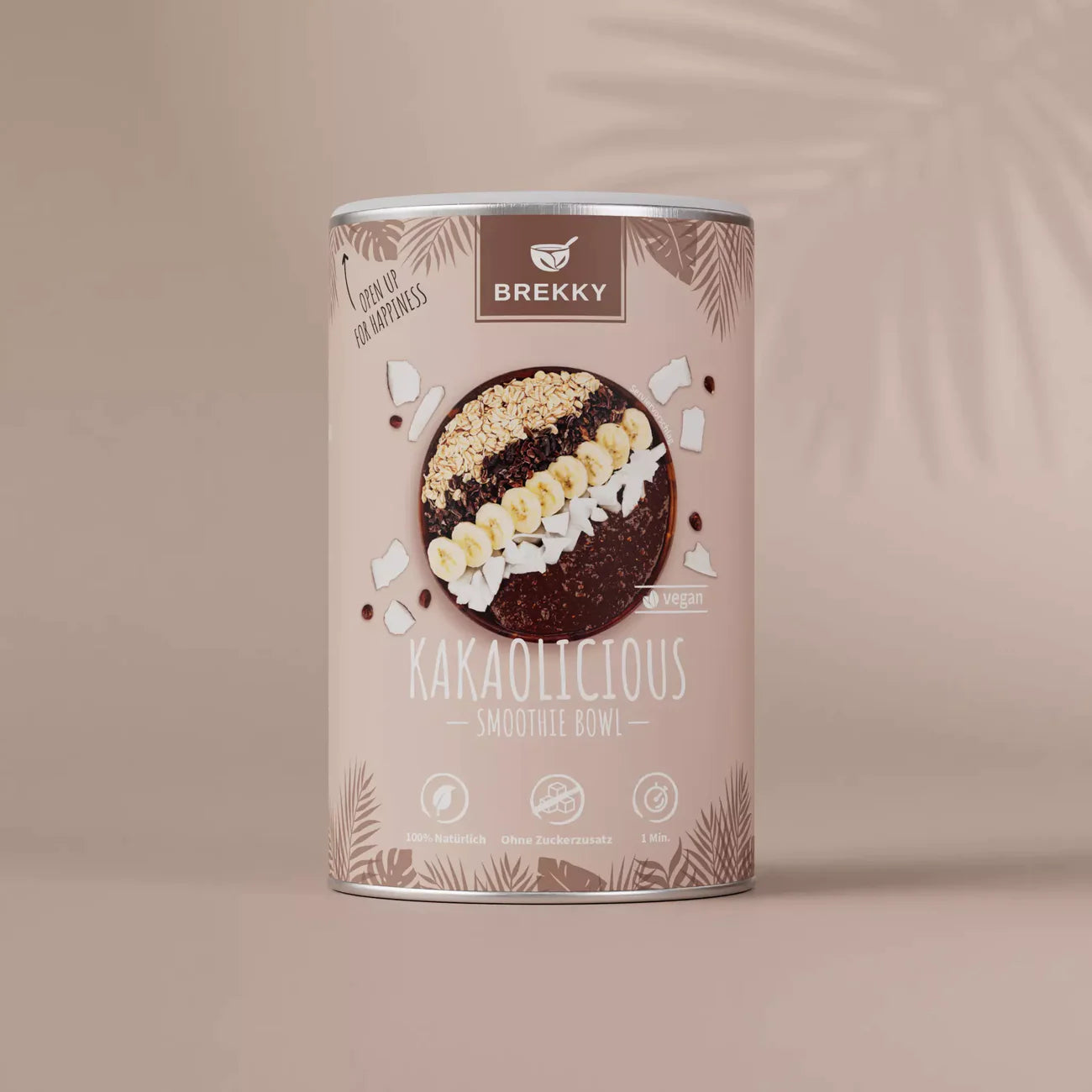
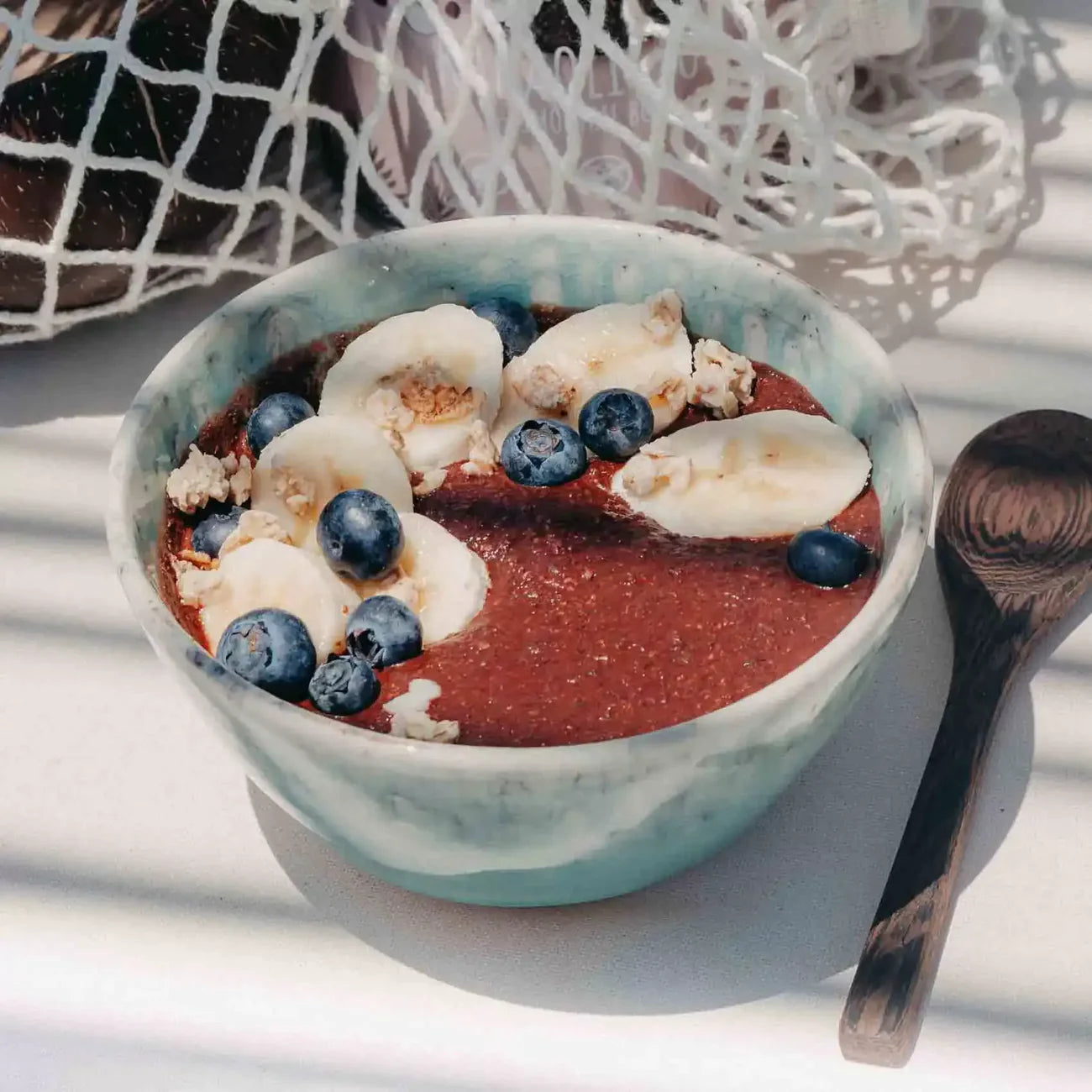

Breakfast in the daycare center and kindergarten
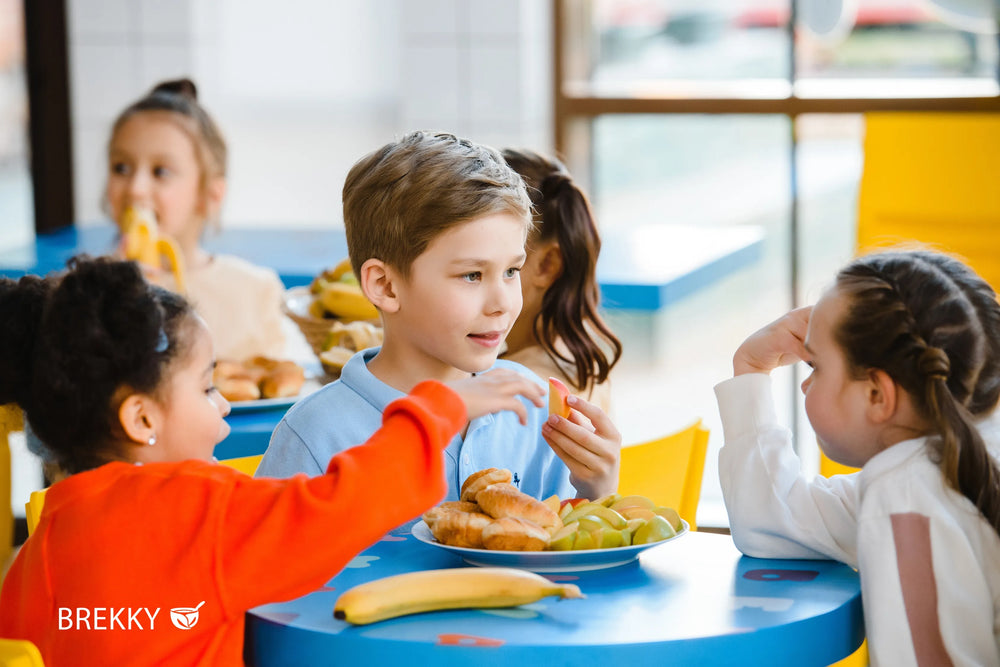
Organizational models for the daycare breakfast
- Bring your own breakfast : Parents are responsible for ensuring that their child brings a suitable breakfast to daycare in a lunchbox. Advantage: You retain control over the food and can adapt it to your child's preferences. Disadvantage: Planning is essential to ensure that breakfast isn't forgotten or becomes too monotonous.
- Central daycare breakfast : The daycare provides breakfast. It's usually based on a weekly menu. The advantage: All children eat the same thing, which often strengthens a sense of community. The disadvantage: Fewer options for individual requests or special dietary requirements, such as food intolerances, are available.
Bring your own breakfast vs. daycare breakfast
Regardless of the model, a healthy and daycare-friendly breakfast can be achieved through fresh fruit, vegetables, whole grain products, and high-quality proteins. If you bring your own food, it's a good idea to make arrangements and perhaps establish common rules so that breakfast remains as free of sweets or sugary snacks as possible. Some institutions have a "sugar ban." This means that anything that clearly contains sugar (e.g., chocolate bars) is discouraged. A major advantage of this approach: children become accustomed to natural sweetness from an early age and learn that a good breakfast for children can also be made without a lot of sugar.
Breakfast ideas for the daycare lunch box
- Whole-grain bread cubes : Cut the bread into small pieces and top them with different toppings: cream cheese, cheese, or lean ham. Variety increases children's curiosity.
- Vegetable sticks : Cut peppers, cucumbers, carrots, or kohlrabi into sticks. Optionally, add a small dip of quark or hummus.
- Fruit packet : A small container of seasonal fruit (apples, pears, berries). To prevent browning, sprinkle apple pieces with a little lemon juice.
- Dairy products : Small cup of natural yogurt, cottage cheese or cream cheese portions.
- Different themes : The classic daycare breakfast can, for example, have a different theme each week (“Red fruit”, “Sugar-free breakfast”, “Daycare breakfast without bread”, etc.) to introduce children to new foods in a playful way.
Shared vs. free breakfast
Some daycare centers celebrate a communal breakfast, with all children gathering around the table. Others offer a free breakfast, where each child decides when they want to eat. Both models can be useful:
- Breakfast together : Promotes community and interaction among children. They learn table manners and experience a variety of food through each other's lunch boxes.
- Free breakfast : Adapts to individual hunger and biorhythms. Some children eat breakfast very early at home, while others prefer to eat at 9 or 9:30. This model takes such differences into account.
It's important that parents and educators work closely together. This is the only way to ensure that a healthy breakfast for children in daycare isn't just lip service, but is actively practiced. The focus is on fostering a positive attitude toward food and showing children, with joy, how diverse a healthy breakfast can be.
Frühstück für die Schule
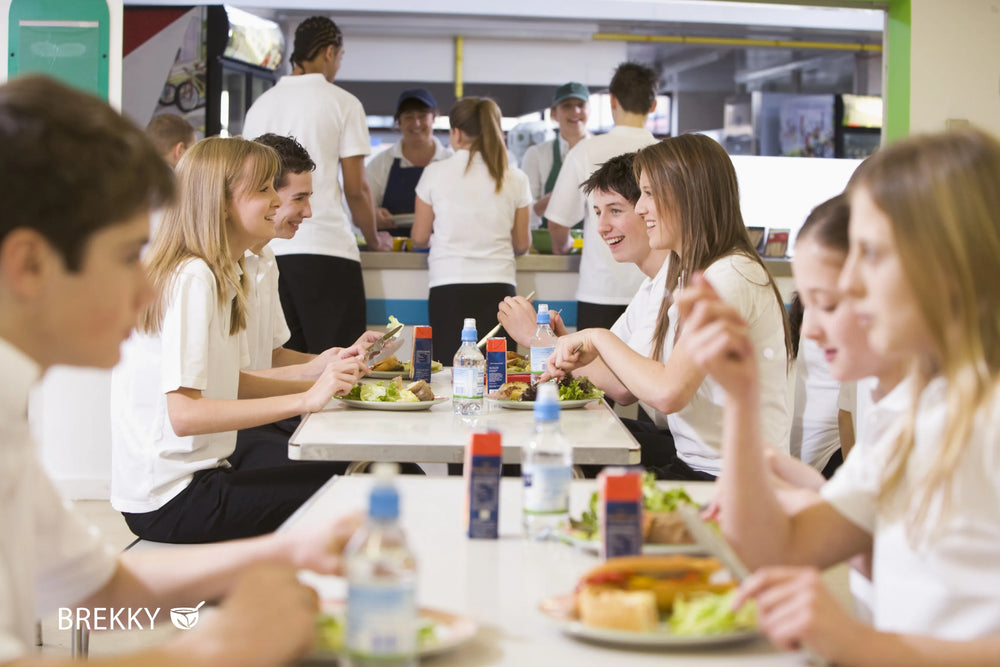
Breakfast before school: meaning and implementation
Many children leave home early and have little appetite in the morning. Nevertheless, it can be beneficial to eat at least a little something to provide the body with energy early on. Breakfast doesn't have to be a lavish meal. Whole-grain bread with spread, a banana, or a smoothie can be enough to keep blood sugar levels stable.
If you're short on time in the morning, you can resort to preparing meals the night before or put together a quick breakfast for kids, such as overnight oats that are already waiting in the fridge. This makes breakfast with children manageable despite tight schedules.
Second breakfast for school
The real challenge often arises during the morning break. Children who don't eat during that time run the risk of being hungry and unfocused. This is where a second breakfast comes in. A mix of carbohydrates, protein, and vitamins is ideal, for example:
- Whole-grain bread with cheese, turkey breast, or vegetarian spreads.
- Vegetable sticks (carrots, peppers, cucumber).
- Small fruits (apple, tangerine, grapes).
- Water or unsweetened tea in a drinking bottle.
Those who like variety can also opt for wraps, (low-sugar) pancake rolls, or homemade granola bars. It's important that breakfast is appealing to students and as convenient as possible.
Practical lunch box ideas
Lunch boxes with multiple compartments are helpful for storing different foods separately. This keeps bread dry and vegetables fresh. The following ideas can help with a healthy breakfast at school:
- Colorful bento box : Small portions of everything: cucumber slices, hard-boiled egg, berries, nuts, and whole-grain bread.
- Mini Sandwich Parade : Distinguish two or three small sandwiches, each with a different topping.
- Yogurt to go : Sealable containers allow you to take yogurt, quark, or smoothies with you. Top with fruit and some freshly sprinkled muesli on the go.
School breakfast projects and programs
Many schools now have projects that focus on a healthy breakfast for children. Some schools organize community breakfast days, workshops, or even regular programs. The goal is to introduce children to a balanced diet at an early age and also to relieve the burden on parents by developing ideas together.
Every school handles this issue differently. If your child's school doesn't offer a breakfast program, it's worth asking the parent council if something can be initiated. A healthy breakfast at school not only has a positive impact on performance but also on the children's overall well-being.







Special breakfasts for children
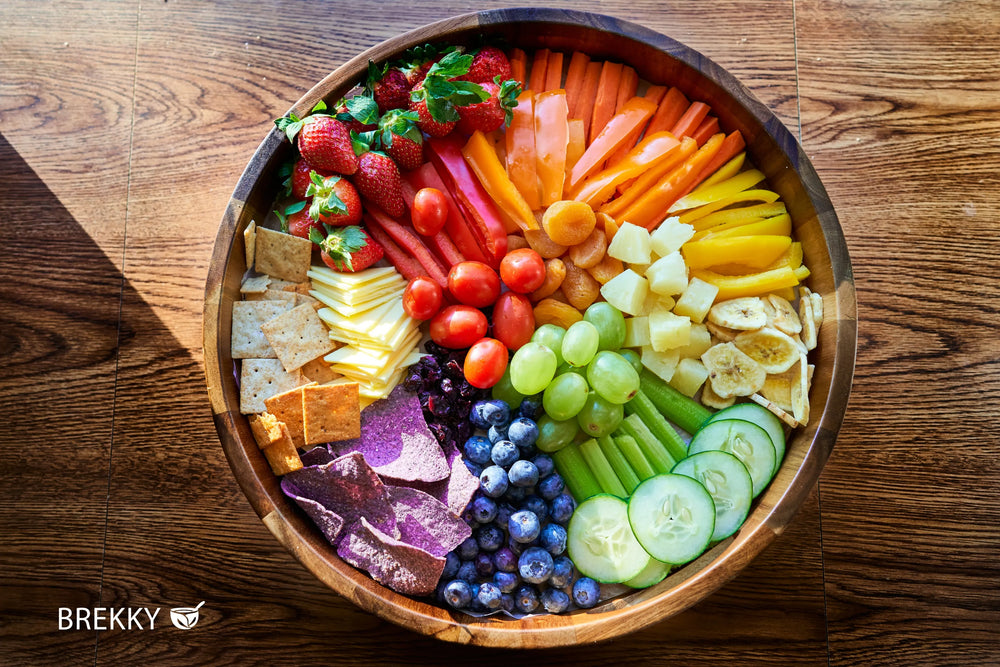
Sugar-free breakfast
A sugar-free breakfast doesn't mean sacrificing flavor. Fruits like bananas or berries are often sweet enough to satisfy your morning cravings. A sugar-free breakfast can include:
- Natural yogurt with berries, a light cinnamon topping, and chopped nuts.
- Oatmeal (porridge) without added sweetness. Apples, pears, or dates, which naturally contain sugar, give it a mild sweetness.
- Whole-grain bread with avocado or hummus, garnished with tomato slices.
Gluten-free breakfast
A gluten-free breakfast is important for children with celiac disease or gluten intolerance. Fortunately, there are now numerous gluten-free grain alternatives, including buckwheat, quinoa, rice, millet, and gluten-free oatmeal.
- Gluten-free muesli : Look for the "gluten-free" label. Combine it with milk, yogurt, or plant-based alternatives.
- Buckwheat pancakes : With a little honey or fruit they become a sweet treat.
- Vegetable Omelette : Eggs contain no gluten and are a versatile base for a nutritious and child-friendly breakfast.
Vegetarian or vegan breakfast
Children can also follow a vegetarian or vegan diet – as long as all the essential nutrients are taken into account. Vegetarian diets primarily focus on dairy products, eggs, and plant-based foods, while a vegan diet eliminates all animal products.
- Vegetarian : Low-fat curd cheese with fresh herbs, cream cheese with chives, whole-grain bread and a boiled egg provide protein.
- Vegan : Plant-based drinks (e.g., oat milk, almond milk), tofu scrambled eggs, hummus or peanut butter as a spread, and a plentiful selection of fruits and vegetables. By paying attention to B12 and including sufficient protein sources, you can ensure a healthy, vegan children's breakfast.
Breakfast for food intolerances
Some children are lactose or fructose intolerant, or have a nut allergy. In such cases, a targeted meal plan can help. With the right knowledge, however, a healthy breakfast can be created even for children with intolerances. For example, if they are lactose intolerant, you can opt for lactose-free dairy products or soy milk. If they are fructose intolerant, vegetables and less sweet fruits (e.g., berries instead of apples) are alternatives.
The most important thing with special breakfasts is to tailor each child's needs to the individual. This way, children feel heard and can enjoy the full flavor of a varied breakfast despite their limitations.
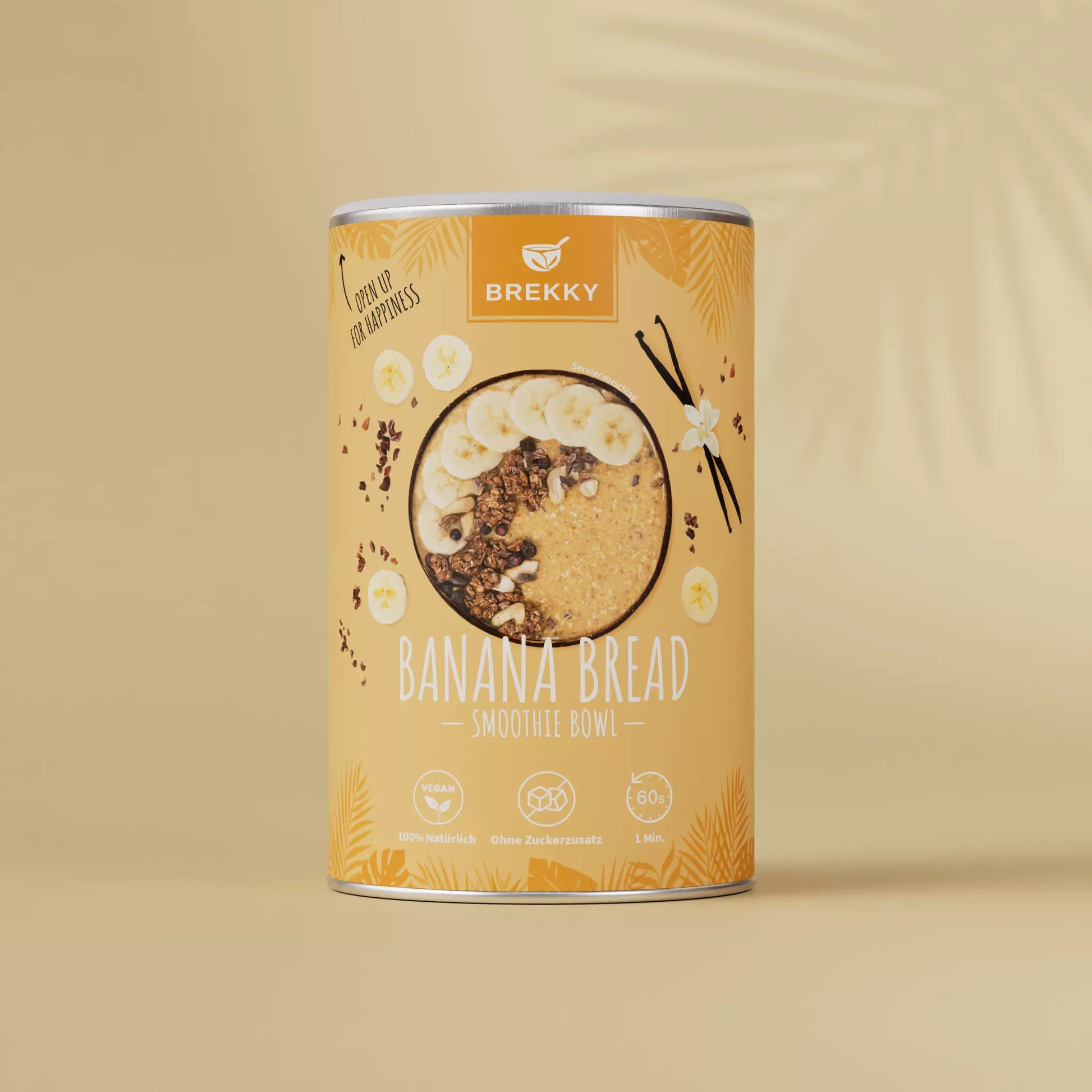
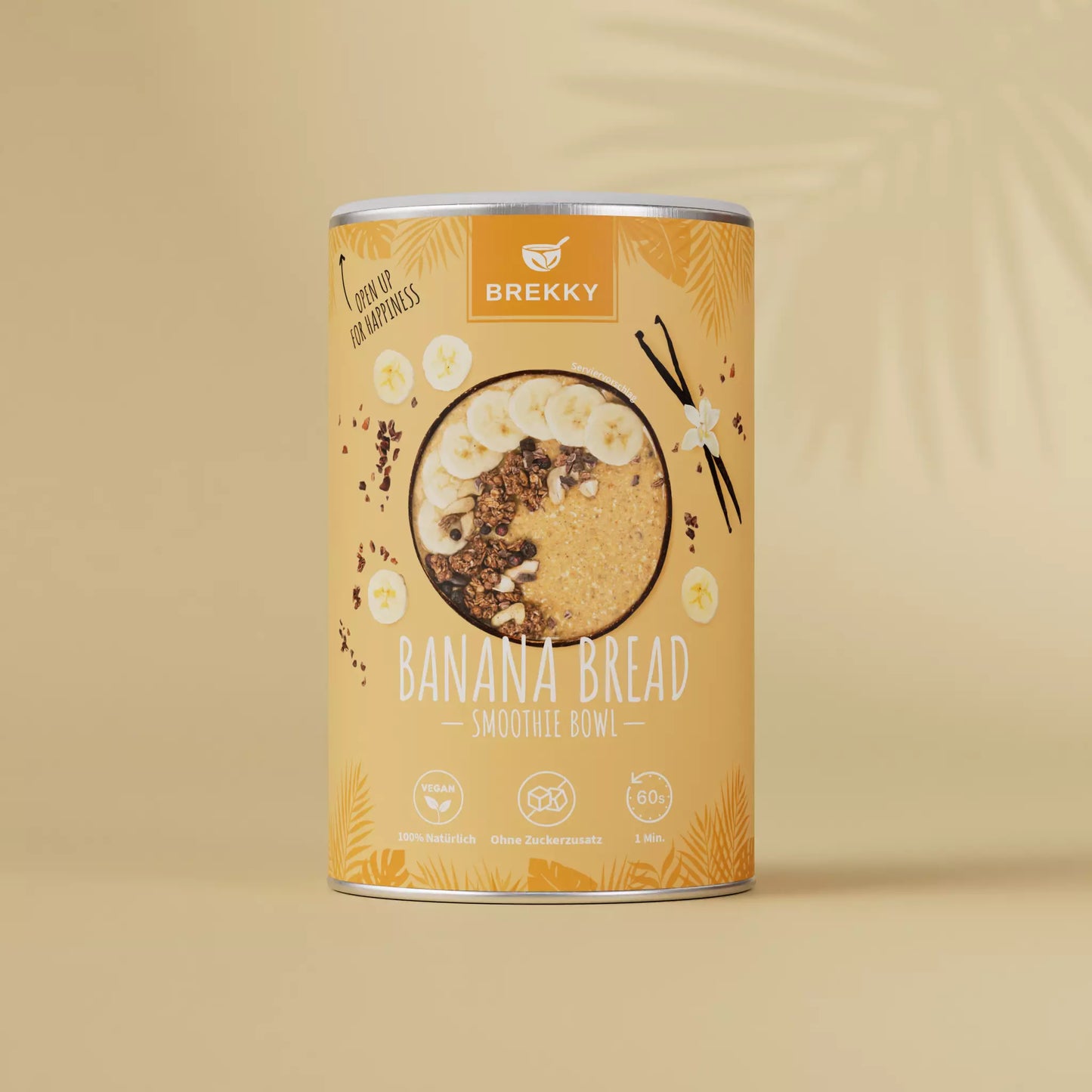

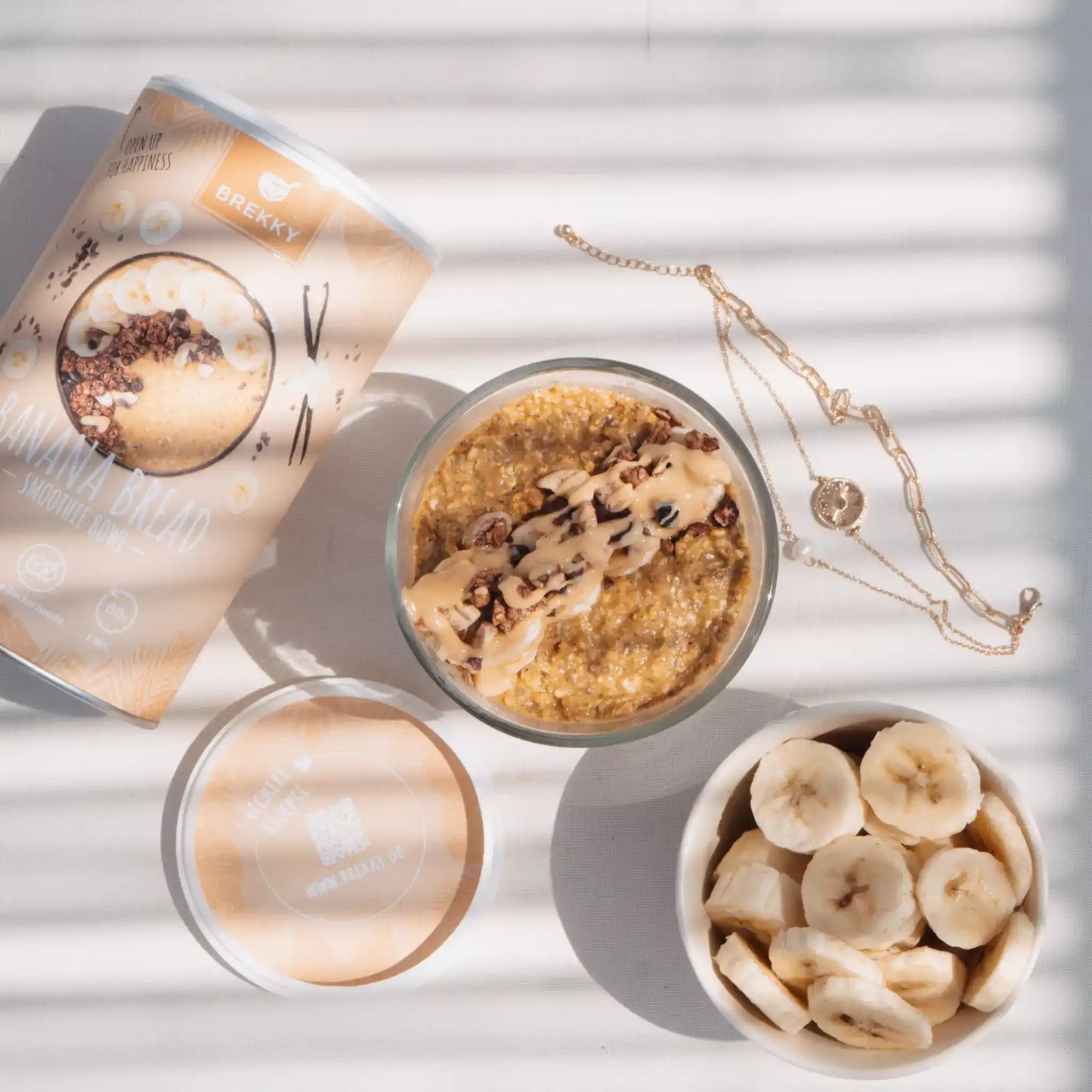
Having breakfast with children
Frühstück zum Mitnehmen
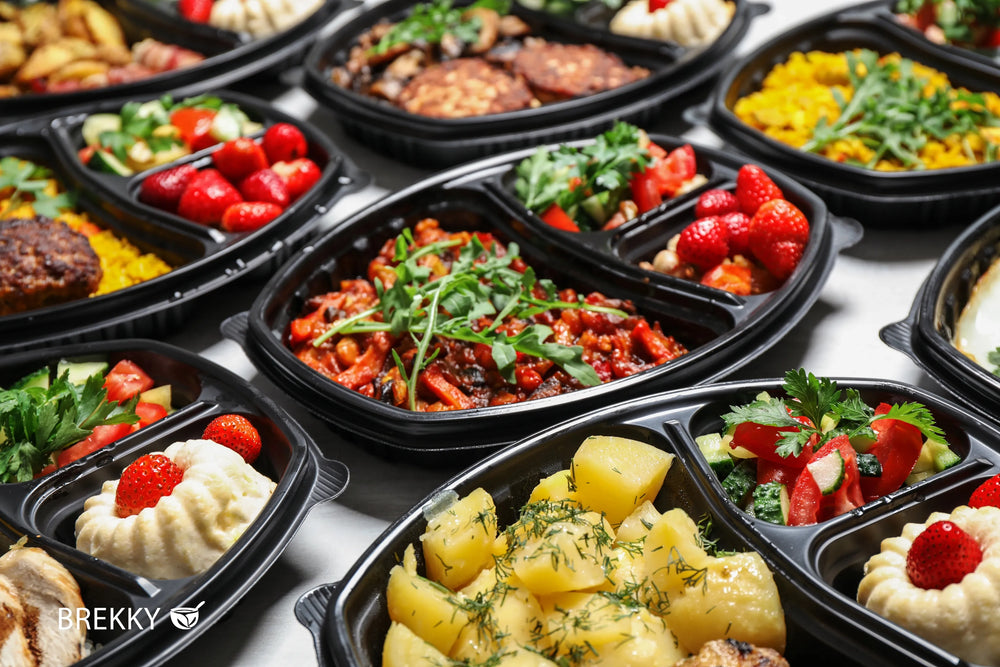
Whether for a day trip, a weekend getaway, or simply on the way to school—sometimes breakfast has to be on the go. A healthy breakfast to go is quickly put together with a few tricks:
- Breakfast in a jar : A small yogurt with oat flakes, berries, and nuts in a screw-top jar. Just clamp a spoon into the lid, and you're done.
- Wraps and sandwiches : Quick to prepare and easy to transport. Make sure the filling isn't too runny to prevent spillage.
- Vegetable sticks and dip : Perfect for short breaks. This way, children enjoy eating raw vegetables on the go.
- Homemade "snack box" : Mix nuts, dried fruit, and whole-grain crackers. Add a small container of cream cheese or hummus.
Even with a grab-and-go breakfast, the basic principles remain the same: whole grains, protein, healthy fats, and vitamins. This makes breakfast suitable for children and everyday meals without having to rely on convenience foods.
Häufige Fragen und Lösungen
Fazit


